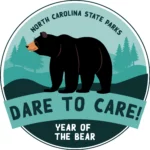In NC, we’ve taken note of a number of anniversaries this year. 2023 was designated as the Year of the Trail because it’s the 50th anniversary of the 1973 North Carolina Trails System Act….


…..And as it turns out, 1973 was a good year for environmental legislation, as it also happens to be the 50th Anniversary of the Endangered Species Act in our country. And, if that wasn’t enough, every year on the 3rd Friday in May, we celebrate National Endangered Species Day to recognize the importance of protecting endangered species worldwide. How are you going to celebrate Endangered Species Day? If you’re not quite sure, we have a great suggestion.
Merchant’s Millpond State Park is one of the most magical places on Earth. We might be a bit biased, but think of beautiful black ribbons of water, cypress and tupelos lounging all day with that water lapping at their trunks. Spanish moss, sunbathing turtles, serenading frogs, and…alligators. Not everyone associates alligators with a peaceful afternoon visit, but give us some time to convince you. This is the most relaxing canoe paddle on the planet, and it’s a picnic lover’s dream. Come for the gorgeous bits of nature that draw you in, and stay for the stories about the American Alligator. You won’t be disappointed.

Once upon a time, it was thought that Gates County was too far north for a population of alligators to survive. Why, you ask? Because successful alligator populations require both males and females and the sex of an alligator depends on the temperature of the incubating eggs. If eggs incubate at temperatures above ~93.2 degrees F, the offspring are mostly male. If eggs incubate below ~86 degrees F, the offspring are primarily female. The sweet spot lies somewhere in between. The mating season in North Carolina runs through May and into June, but in northern North Carolina, it would not have been uncommon in past years for temperatures during this period to stay below the 86 degree mark, meaning that any population that MAY have been able to get started, would have likely ended up as mostly females. If temperatures from time to time creeped higher and a few males were born, there was a chance for survival and reproduction. But with lower temperatures, breeding would have been impossible. With climate change looming as part of our everyday existence, this ecological scenario, once thought unlikely, is now a reality. Merchant’s Millpond now hosts a healthy population of American alligators, and we’re pretty thankful that they’re there. Want to know why? Of course you do!
Alligators are apex predators. That means they sit at the very top of the food chain, much like people do. There aren’t many things out there that can hunt and kill alligators, except for man, an issue that led to a drastic decline in the American alligator population in the 60s and 70s all across the southeast U.S. It was at this point that the Endangered Species Act was created and the American alligator was placed under protection. Fifty years later, it is one of the most successful stories in the history of the Endangered Species Act. The American alligator is no longer in danger.

Now some of you are still wondering why we care if alligator populations are low. Don’t they attack people? Well, no, not really. If you get into their nesting territory, they will defend it. If you get within an unsafe distance of any wild animal, you should know that they will defend themselves, just as you would if you felt threatened. That is nature. But the real question that you should be asking is “what is their role in nature – What is their Ecological Niche?” and that is a question worth exploring.
American alligators live in and near wetland habitats. Wetlands are natural areas that flood often, but they never dry. As the name suggests, they must stay wet. Sometimes they have standing water, sometimes the water recedes, but the sediments never dry out. And this is a good thing, because wet wetlands hold carbon – A LOT OF IT – even more than forests. But when wetlands dry, all the carbon is released. We need wetlands. Fortunately for us, North Carolina has many different kinds of wetlands, and currently, about 17% of our land is classified as wetlands (Dahl, 1990). This number has decreased dramatically and this is where alligators live. Sometimes in wetlands the water becomes stagnant. This is particularly common in the summer when turnover in the water column doesn’t occur very often. The water on top warms from the sun, nutrients run into the water, and algae starts to grow. But when lots of growing algae die and bacteria move in to break down the algal cells, all the oxygen is used up, and other living things begin to die too. The water and the sediments can become hypoxic – no oxygen, therefore toxic. And life just can’t survive under those conditions. This is called eutrophication. But there is a way to help this scenario.
Large apex predators, like the American alligator, move the water column around. They swim through the water, mixing it. They dive down to the bottom, stirring it up. They hunt for food, and their movements help to prevent eutrophication. So fish can dart, snakes can slither, frogs can sing, and turtles can sunbathe. Thank you very much to our dear friend the American alligator. Life would not be the same without you.
References
“Thirty Great North Carolina Science Adventures: From Underground Wonderlands to Islands in the Sky and Everything in Between” Ed. by April C Smith and Sarah J. Carrier, 2020, UNC Press, Chapel Hill, NC.
NC State Parks. Reptile Checklist at Merchant’s Millpond State Park. https://auth1.dpr.ncparks.gov/nrid/checklist_public.php?park=memi&mg=reptile
Dahl, T E. Wetlands losses in the United States, 1780’s to 1980’s. Report to the Congress. United States: N. p., 1990. Web.

